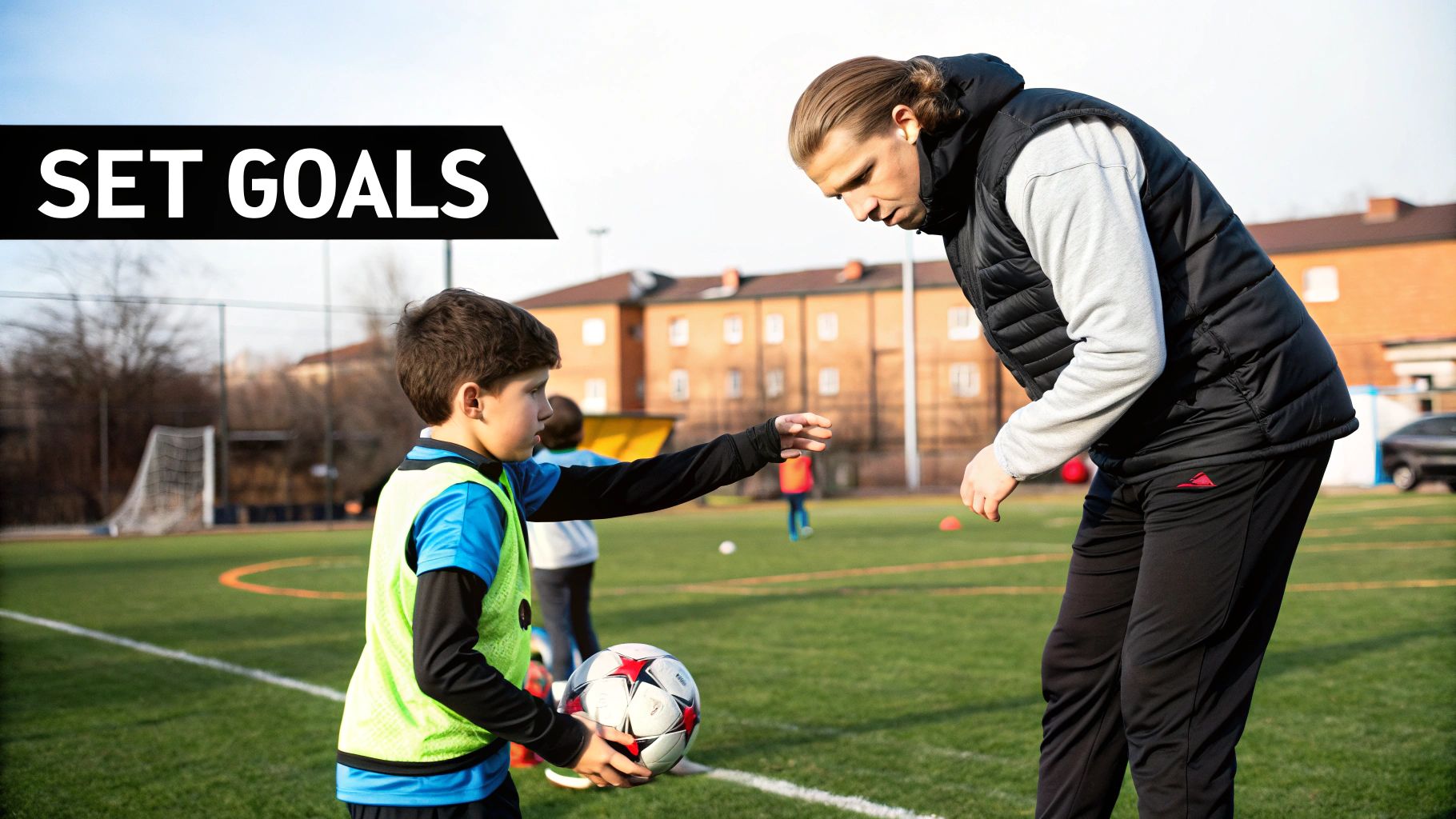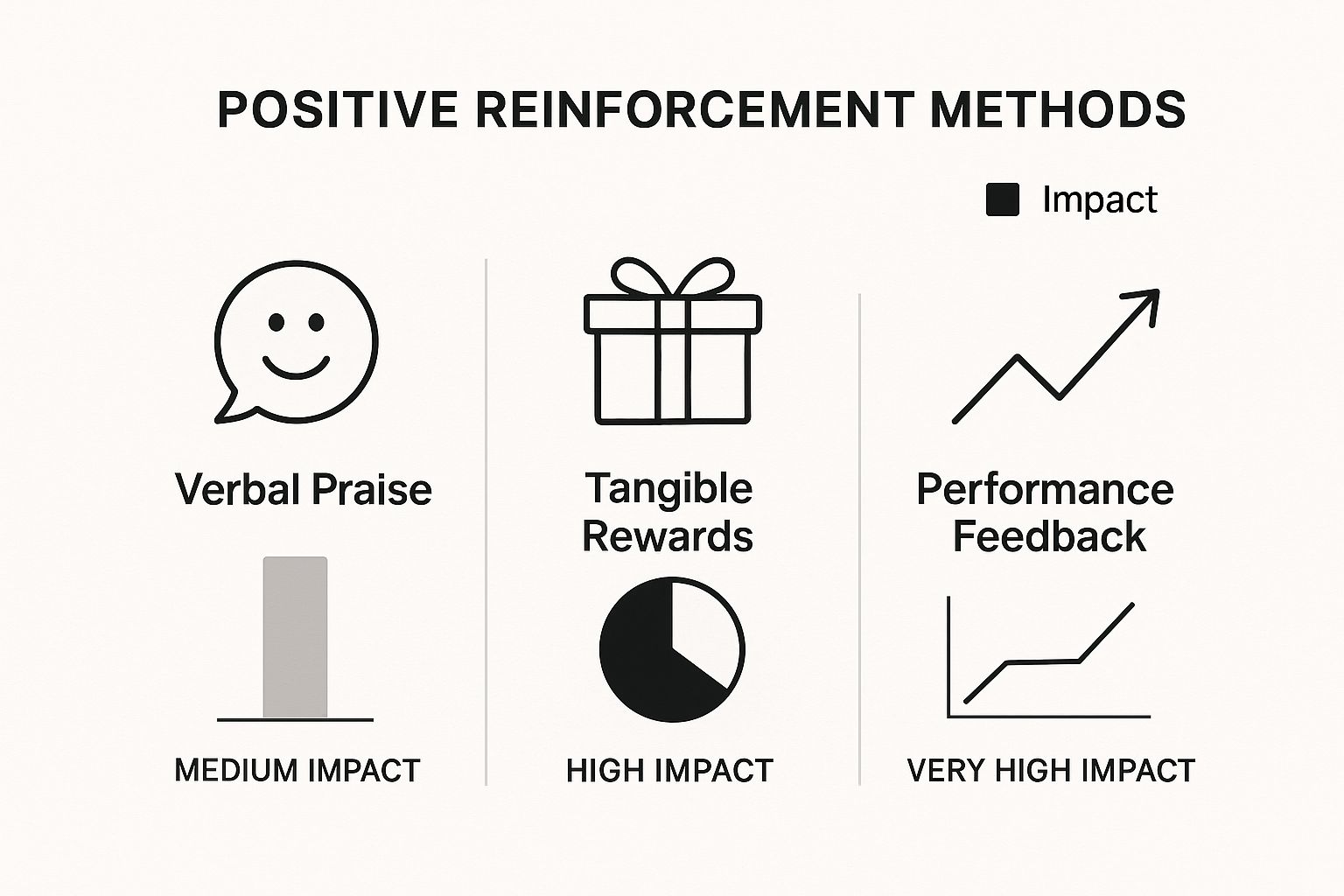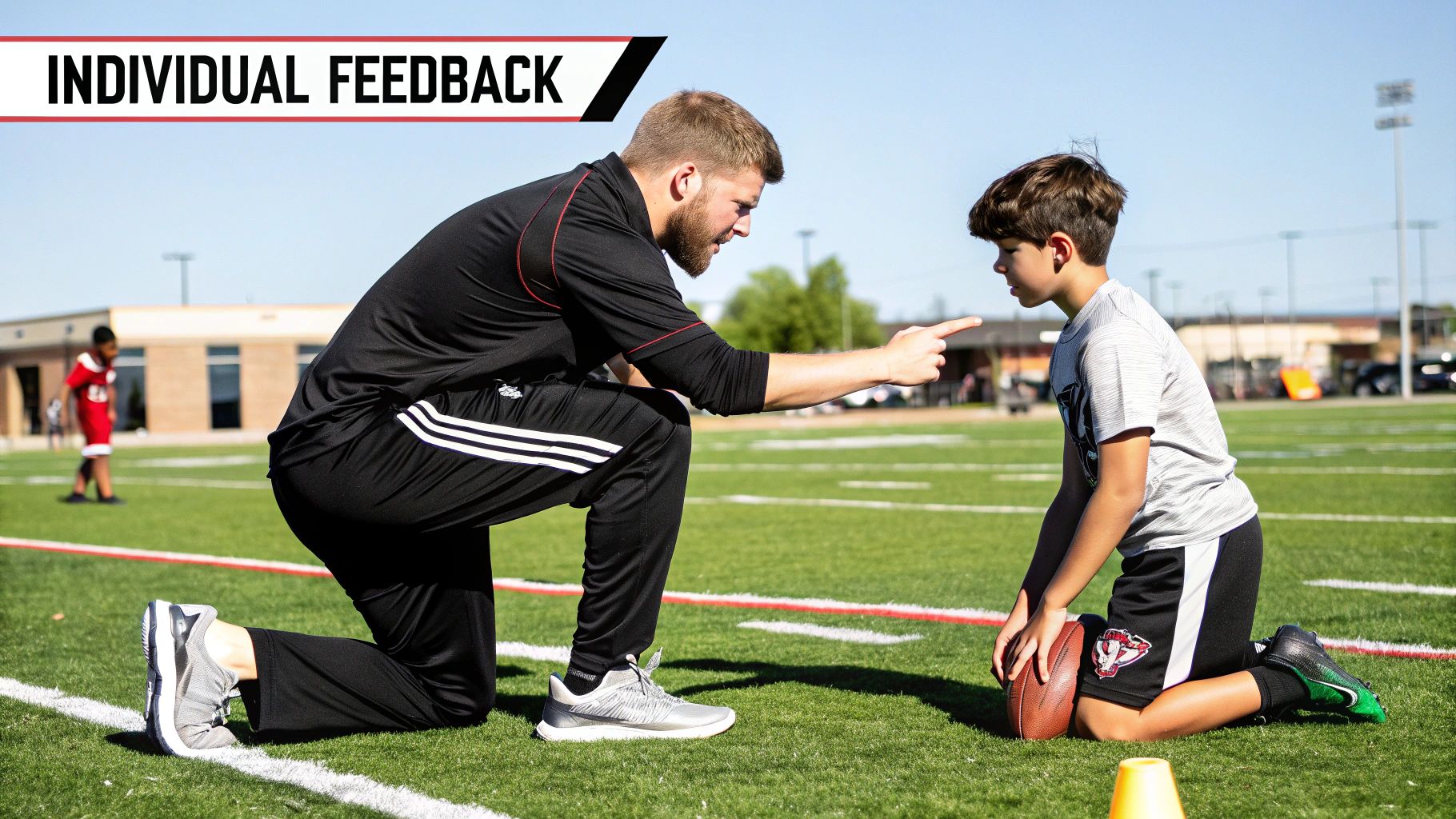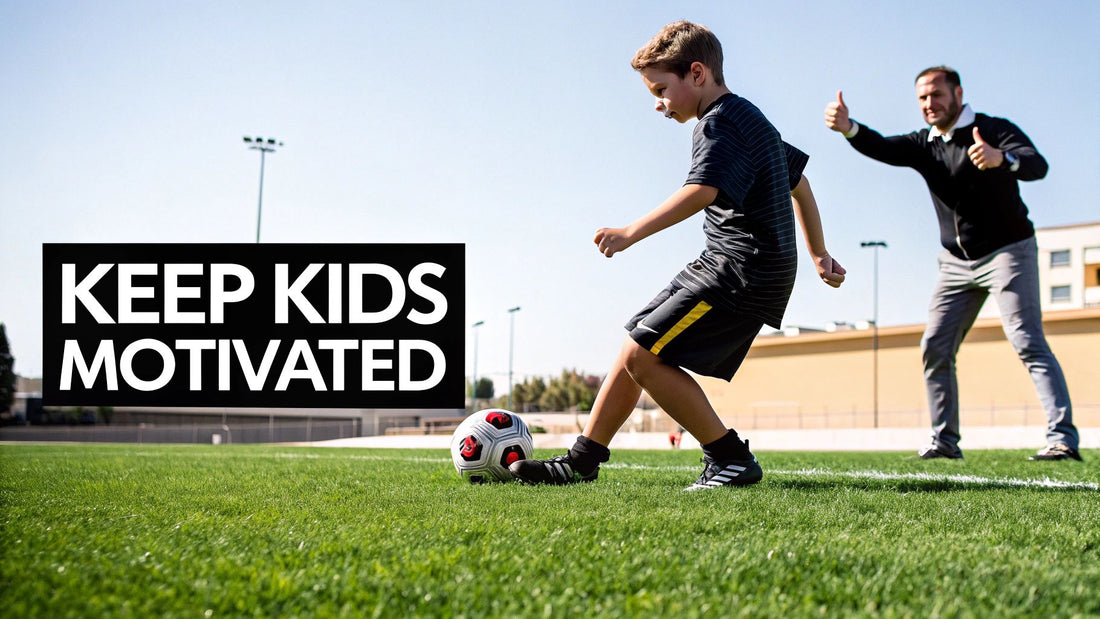Keeping young footballers fired up is all about one thing: making it fun. Forget the scoreline for a moment. Instead, focus on small, achievable wins, celebrate personal progress, and build an environment where they aren’t afraid to try new things.
When kids feel they're improving and enjoy playing with their teammates, their love for the game takes care of itself. Motivation isn't something you force; it’s the natural result of them having a brilliant time.
Why Kids Fall in Love with Football (and Why They Sometimes Fall Out of It)
For millions of children across the UK, football is practically a rite of passage. It starts with a kickabout in the park and blossoms the first time they pull on a proper team kit. That initial buzz is powerful. It’s built on simple, pure joys: the friendships, the thrill of a goal, and the freedom of running around with their mates.
This isn't just a feeling; the numbers back it up. Football is still the undisputed king of school sports. During the 2023-24 academic year, a massive 40 percent of children played football regularly, showing it’s as central to childhood as ever. You can see the full breakdown on the official Statista report. This early passion is what gets them started.
But as any parent or coach knows, that initial spark can sometimes flicker. Understanding why is the first step to keeping them in the game for the long haul.
The Motivation Killers to Avoid
When a child starts to lose interest in football, it’s rarely about the sport itself. It’s almost always down to external pressures or a shift away from what made it enjoyable in the first place.
Here are a few of the usual suspects that can drain the fun from the game:
- Too Much Pressure: When winning becomes the only thing that matters to the adults on the touchline, a fun Saturday morning can quickly feel like a high-stakes exam.
- Boredom on the Pitch: Endlessly repetitive drills with no game time at the end? That’s a one-way ticket to a player switching off. Training must feel fresh and purposeful.
- The Fear of Making a Mistake: If a kid is terrified of misplacing a pass or missing a shot, they’ll stop trying anything creative. Football should be a space where they feel safe to experiment and fail.
The real win isn’t raising the next superstar. It’s nurturing a lifelong passion for being active, working as a team, and simply loving the beautiful game.
Once you can spot these pitfalls, you can start building an environment that protects that passion. That’s how you make sure their football journey is a long and happy one, no matter where it leads.
At-a-Glance Motivation Boosters
For a quick summary, here are the core strategies parents can use to keep their young players engaged and enthusiastic. Think of this as your go-to checklist for the car ride home or before a big match.
| Motivation Strategy | Key Action for Parents | Why It Works |
|---|---|---|
| Focus on Effort, Not Outcome | Praise their hard work, a great tackle, or a brave pass, regardless of the final score. | It teaches them that progress and resilience matter more than winning, building a growth mindset. |
| Set Small, Personal Goals | Work with them to set achievable targets, like "complete five passes with my weaker foot" or "make three good runs." | This gives them a sense of control and accomplishment, even if the team loses. |
| Embrace Variety | Encourage them to play in the garden, try different positions in training, or just have a kickabout with friends. | It prevents burnout from structured drills and reminds them that football is, first and foremost, a game. |
| Be Their Biggest Fan, Not Their Harshest Critic | Keep touchline comments positive. After the game, ask "Did you have fun?" before asking "Did you win?" | It creates a safe, pressure-free space where they know your support is unconditional. |
Creating a positive environment isn’t about shielding them from reality; it's about framing their football experience around personal growth and enjoyment. When those two things are the priority, motivation naturally follows.
Make Football Fun Before Anything Else

Before we talk tactics, trophies, or team sheets, let’s get one thing straight: kids play football because it’s fun. Simple as that. The moment the enjoyment disappears, so does their motivation. As a parent or coach, your number one job is to protect that fun, creating a space where a genuine love for the game can grow.
This means pulling the focus away from results and putting it squarely on the experience. Think about the car ride home after a match—it's a make-or-break moment. Instead of launching into a tactical debrief of what went wrong, try asking simple, open questions. "What was your favourite part of the game today?" or "Did you and your mates have a good laugh out there?"
This simple shift reframes everything. It reminds them that football is about more than the final score. It builds a foundation where they feel safe enough to try a new skill, make a mistake, and just enjoy having a kickabout with their friends.
Celebrate Effort Over Outcome
One of the fastest ways to kill the fun is to create a pressure-cooker environment where winning is everything. When a child's sense of achievement is tied only to the result, football stops being a game and starts feeling like a job. The secret is to celebrate the things they can actually control.
Instead of only cheering for goals, praise the specific actions you saw:
- "That was a brilliant tackle you made in the first half!"
- "I loved how you kept running and trying your best right until the final whistle."
- "It was great to see you encourage your teammate after they missed that shot."
This kind of feedback reinforces the value of hard work, resilience, and being a good teammate. It shows them you see their effort, which builds a much deeper and more lasting confidence than a fleeting victory ever could.
Creating a positive environment isn’t about ignoring losses; it’s about making sure your child’s happiness doesn’t depend on the result. Their long-term motivation is built on good memories, not just the number of wins.
Nurturing a Pressure-Free Environment
A pressure-free atmosphere is absolutely vital for keeping kids motivated. This kind of positive setting encourages them to take risks and be creative without worrying about being shouted at from the sidelines. When training sessions are inclusive and varied, young players are far more likely to stick with it.
And it’s not just a hunch—the data backs it up. Sport England’s Active Lives survey shows a clear link between supportive, fun coaching and children’s motivation. The research found that when clubs prioritise positive environments, player retention shoots up. In fact, during the 2022-23 period, around 70% of youth football participants in England kept playing after their first year in these supportive clubs. You can dive into the details by exploring the full Sport England research.
To help build this environment at home, you can introduce different activities to keep things fresh. Using a variety of equipment can make practice feel like playtime rather than a chore. For a few ideas on how to mix things up, have a look at our guide on the best soccer training equipment for kids.
Ultimately, your role is to be their biggest fan, cheering on their progress and celebrating their love for the beautiful game.
Set Goals That Actually Build Confidence

Vague praise like "good job" or "well done" wears thin pretty quickly. For motivation to really stick, it has to be built on a foundation of tangible achievement. To keep kids fired up about football, we need to help them shift their focus from the things they can't control—like winning the match—to small, personal goals they can absolutely nail.
This means getting away from targets like "score two goals today." A young player can have the game of their life and still not find the back of the net, leaving them feeling like they’ve failed. Instead, let's redefine what success looks like on the pitch.
When we break it down into achievable actions, we create a powerful feedback loop. Progress, not just victory, becomes the reward. That’s how you build a resilient and confident mindset that’ll serve them well beyond the touchline.
Focus on Process, Not Prizes
The best goals are the ones entirely within your child's control. They need to be specific, measurable, and tied to their own development, not the team's final score. This approach empowers them to see their own improvement, week in and week out, which is a massive driver for long-term passion.
So, what does a successful game look like in terms of effort and skill? Think smaller.
- Passing: Instead of just hoping for an assist, try: "Aim to make five confident passes to a teammate." This puts the focus on good decision-making and execution.
- Weak Foot: Encourage them to step outside their comfort zone with something like: "Use your weaker foot at least three times during the match." It's a low-pressure way to build a vital skill.
- Defending: Value the dirty work just as much as the attacking flair. A goal could be: "Stick with your player and try to make two clean tackles."
A child who achieves their personal goal of 'making three good runs' will feel a genuine sense of accomplishment, even if their team loses 3-0. This feeling of personal success is the secret to keeping their passion alive.
Tracking and Celebrating Small Victories
Once you’ve helped them set these mini-goals, the next step is crucial: acknowledge their progress. This doesn’t need to be a formal debrief after the game. It can be a simple, positive comment on the drive home.
Saying, "I saw you use your left foot in the second half, that was brilliant!" reinforces that you’re noticing the effort, not just the outcome.
This is where a bit of practice at home can make a massive difference. Working on specific skills makes these in-game goals feel much more achievable. You can find plenty of exercises to support this in our guide to beginner soccer drills, which are perfect for building that foundational confidence.
Celebrating these small wins helps your child connect practice with performance. It teaches them that hard work leads to real, noticeable improvement—a lesson that's far more valuable than any single trophy. That understanding is what truly helps to keep kids motivated in football for the long haul.
Keep Training Fresh and Engaging
Nothing kills a kid's love for football faster than boredom. Let's be honest, running the same passing drills around the same cones, week in, week out? It quickly turns the beautiful game into a chore, and motivation takes a nosedive. The trick is to keep training sessions varied, dynamic, and—most importantly—fun. You want them developing skills without even realising they're working hard.
Instead of endless laps, think like a kid. Why not turn skill development into a game? A chaotic round of "football bulldog" or a small-sided "capture the flag" with a ball will teach dribbling, evasion, and spatial awareness far better than a rigid cone drill ever could. It brings in a bit of friendly competition and a lot of laughter, keeping them hooked.
This kind of variety is absolutely vital for long-term development. It prevents burnout and serves as a constant reminder that football, at its core, is meant to be enjoyed. The simple excitement of not knowing what’s coming next is what keeps them sprinting back to training with a smile on their face.
The Power of Play and Proper Gear
Never underestimate the power of a simple kickabout. Unstructured play at the park with friends, free from the watchful eyes of coaches and the pressure of organised drills, is where real creativity is born. It’s in those moments that kids try that audacious flick they saw on TV, experiment with their skills, and just fall in love with the feeling of the ball at their feet.
Just as important is making sure they're comfortable and safe while they play. You'd be surprised how often ill-fitting or poor-quality gear becomes a silent de-motivator. A pair of football boots that cause blisters or flimsy shin pads that don't stop a knock can quickly drain a child's confidence.

If playing football is physically unpleasant, their motivation will disappear, no matter how much they love the game. Preventing those minor discomforts is one of the easiest wins for any parent or coach.
Making sure they have comfortable, well-fitting boots and proper protective shin pads makes a huge difference. It’s a simple gesture that shows you value their comfort and safety, letting them focus on what really matters—having fun.
We've all seen the difference between a kid who feels good in their kit and one who's constantly fidgeting with a shin pad that’s slipping down. It’s night and day.
To give you a better idea of how different training approaches land with kids, here's a quick comparison.
Keeping Training Fresh vs Sticking to Drills
| Aspect | Varied, Fun-Based Training | Repetitive Drills |
|---|---|---|
| Engagement | High. Kids are actively involved and excited to participate. | Low. Can lead to boredom and players just going through the motions. |
| Skill Development | Develops creative, adaptable skills in game-like scenarios. | Builds specific, isolated skills but can lack in-game application. |
| Motivation | Boosts intrinsic motivation and a genuine love for the sport. | Can feel like a chore, reducing long-term passion for the game. |
| Burnout Risk | Low. The variety keeps things interesting and prevents mental fatigue. | High. The monotony is a leading cause of kids dropping out of sports. |
| Creativity | Encourages problem-solving, flair, and trying new things. | Can stifle creativity by focusing on rigid, pre-defined movements. |
| Team Bonding | Excellent. Fun games and challenges naturally build camaraderie. | Limited. Often focuses on individual execution rather than team interaction. |
As you can see, while traditional drills have their place for mastering a specific technique, a fun-based approach wins hands-down for keeping young players engaged and developing a lifelong passion.
Weaving in Technology and New Ideas
In a world where kids are surrounded by tech, why not use it to our advantage? There are some fantastic apps and digital tools out there designed to make football practice more interactive. They can offer virtual challenges, skills tutorials, and a fresh way to learn that feels more like a game than training.
For parents wanting to mix things up at home, exploring football training apps for children can be a brilliant way to add another layer to their development. It gives them a sense of ownership and a new way to practise.
By mixing traditional games, unstructured kickabouts, and a few modern tools, you create a rich, stimulating environment where a genuine love for football doesn't just survive—it thrives.
Find a Truly Supportive Team Environment

A kid's bond with their coach and teammates is one of the single biggest factors in whether they stick with football for the long haul. The right team can feel like a second family—a place where they feel safe, important, and genuinely excited to play. On the flip side, a negative or overly intense atmosphere can kill their passion for the game faster than anything else.
Finding this kind of community is just as crucial as any on-pitch tactic. It’s about creating a true sense of belonging for every single player, whether they're the star striker or a defender still finding their feet. When a child feels like they truly matter to the group, their commitment and enjoyment will go through the roof.
What to Look for in a Great Coach
A great youth coach is so much more than a tactical genius. They're a mentor, a motivator, and a role model all rolled into one. Their influence is massive, so it’s worth paying close attention to how they handle themselves on the touchline and in training.
Look for a coach who:
- Communicates Positively: They offer constructive pointers, not just criticism. They praise effort just as much as skill. Their language should build players up, never tear them down.
- Ensures Fair Playing Time: Look, not everyone can play every minute. But a good coach makes a visible effort to give everyone meaningful time on the pitch over the season.
- Focuses on Development: Their main goal is to improve every kid's confidence and ability, not just to win silverware. They get that long-term growth is the real prize.
A coach's core mission at grassroots level should be to make every player want to come back next season. If they’re doing that, they’re succeeding in the most important way possible.
The Power of a Positive Club Culture
A healthy club culture is about more than just one great coach. It's about creating a welcoming vibe for everyone involved, from the players on the pitch to the parents on the sidelines. This is something The Football Association (FA) is really pushing with its focus on grassroots development.
And it’s working. Initiatives aimed at inclusion are having a huge impact. The FA has seen participation for women and girls double over the last six years, with nearly one million girls now involved in their largest-ever football events. It just proves that when you build welcoming spaces, young players want to be a part of it. You can read more about it in The FA's grassroots strategy.
When you're checking out a new club, watch for the little things. Do the older teams cheer for the younger ones? Are the parents encouraging to all the players, not just their own? These are the tell-tale signs of a community that understands what really matters.
Ultimately, it’s this sense of belonging that turns a football team into something special. It teaches teamwork, resilience, and friendship—lessons that stick around long after the final whistle. When your child is part of a supportive team, their motivation isn’t just fuelled by a love of the game, but by a love for the people they share it with.
Common Questions from Football Parents
Even with the best intentions, every football parent runs into tricky situations. We've all been there—navigating tough conversations, managing our own stress on the sidelines, or just trying to say the right thing.
Knowing how to handle these moments can be the difference between your child falling out of love with the game and them pushing through a tough patch. Here are some honest answers to the questions we hear most often.
What Should I Do If My Child Wants to Quit?
It’s the conversation every parent dreads hearing. When your child says they want to hang up their boots for good, the most important thing you can do is just listen. Don't immediately jump in with solutions or try to talk them out of it.
Find a quiet moment and ask some gentle, open-ended questions to get to the real heart of the matter. Is it a problem with a teammate? Are they feeling overwhelmed by pressure from the coach? Or maybe, just maybe, they’re simply not enjoying it anymore.
Often, it isn't football itself that’s the problem, but something surrounding it. Once you understand the ‘why’, you can start working on a solution together. Perhaps a short break is all they need, or a quiet word with the coach could clear up a misunderstanding. The key is to show them you’re on their team, no matter what.
How Much Training Is Too Much?
Burnout is a genuine risk in youth football, and it can sneak up on you. The "right" amount of training really depends on your child’s age and how serious they are about the sport. A good rule of thumb is to make sure they have at least one or two rest days per week, completely away from any organised sport.
For the younger ones (ages 6-9), two sessions a week plus a match day is more than enough. As they get older (ages 10-13), that might creep up to three sessions, but you have to be vigilant. Keep a close eye out for signs of fatigue or a noticeable drop in their usual enthusiasm.
A kid’s motivation runs on energy and enjoyment. If they’re constantly tired, complaining of soreness, or dragging their feet to practice, that’s a massive red flag. Their schedule needs a rethink. Remember, rest is just as vital as training for their long-term development.
When to Push and When to Let Go
This is probably the trickiest balancing act for any sports parent. How do you know when to give a gentle nudge versus when to just back off completely? The best approach is to figure out if it's a temporary blip or a genuine, long-term unhappiness.
If your child is just having an off day or feeling nervous before a big game, a bit of encouragement can work wonders. Remind them of their goals, why they started playing, and how much fun they have with their mates.
However, if they’re consistently showing signs of stress, anxiety, or a total lack of interest for weeks on end, pushing them harder is only going to make things worse. This is the time to let go, listen, and have an honest chat about whether the sport, the team, or the current level of commitment is still the right fit. You can't force motivation—it has to come from them.
How Can I Handle Sideline Pressure from Other Parents?
The touchline can sometimes feel more competitive than the pitch itself. The key to surviving it is to stay laser-focused on your own child and your own values. Don't get sucked into moaning about the referee, criticising the coach, or commenting on other players.
If you find yourself next to that parent, politely excuse yourself and find another spot to watch the game in peace. Your role is simple: be your child’s biggest and most positive supporter. That’s the energy they need to see and feel from the sidelines.
By focusing on your child’s effort and enjoyment, you’re not just helping them stay motivated—you’re setting a powerful example and helping build a better, more supportive culture for the entire team.
At SoccerWares, we believe the right gear makes a huge difference to a young player’s comfort and confidence. From supportive shin guards to stylish club apparel that lets them show their pride, we’ve got everything your child needs to feel their best on and off the pitch. Check out our full collection at https://soccerwares.com.

